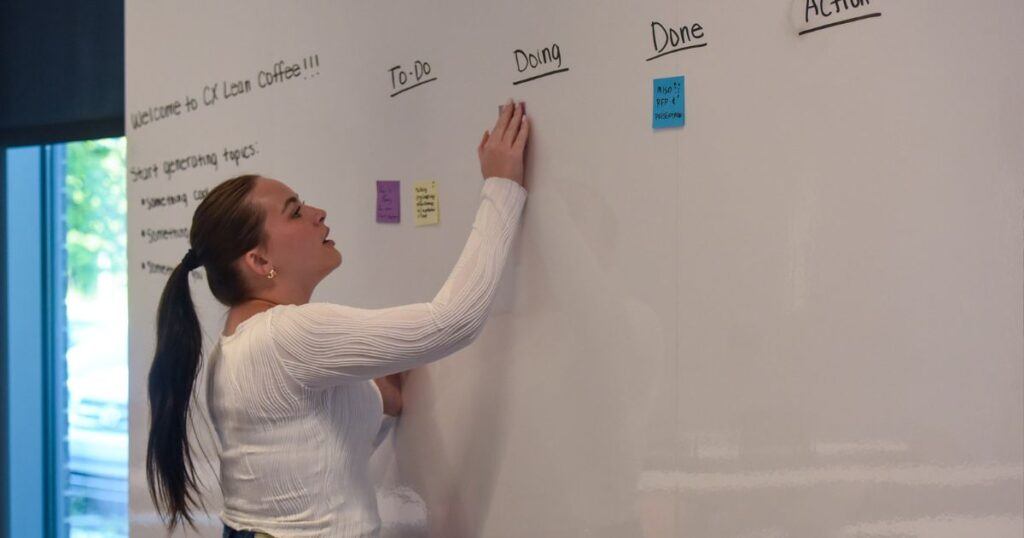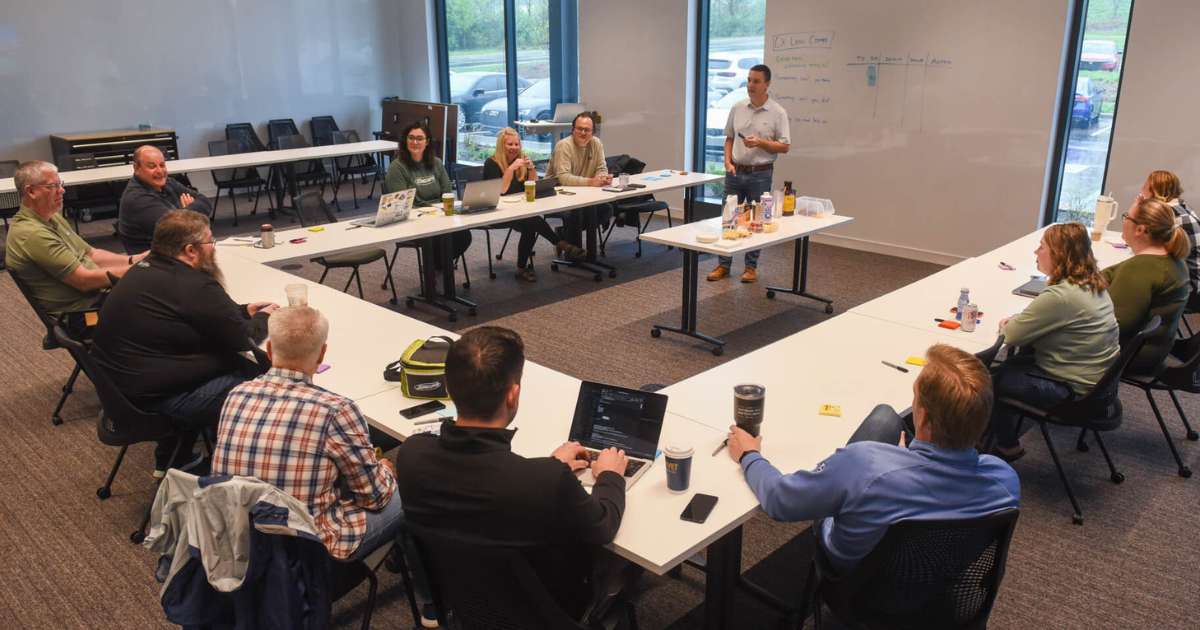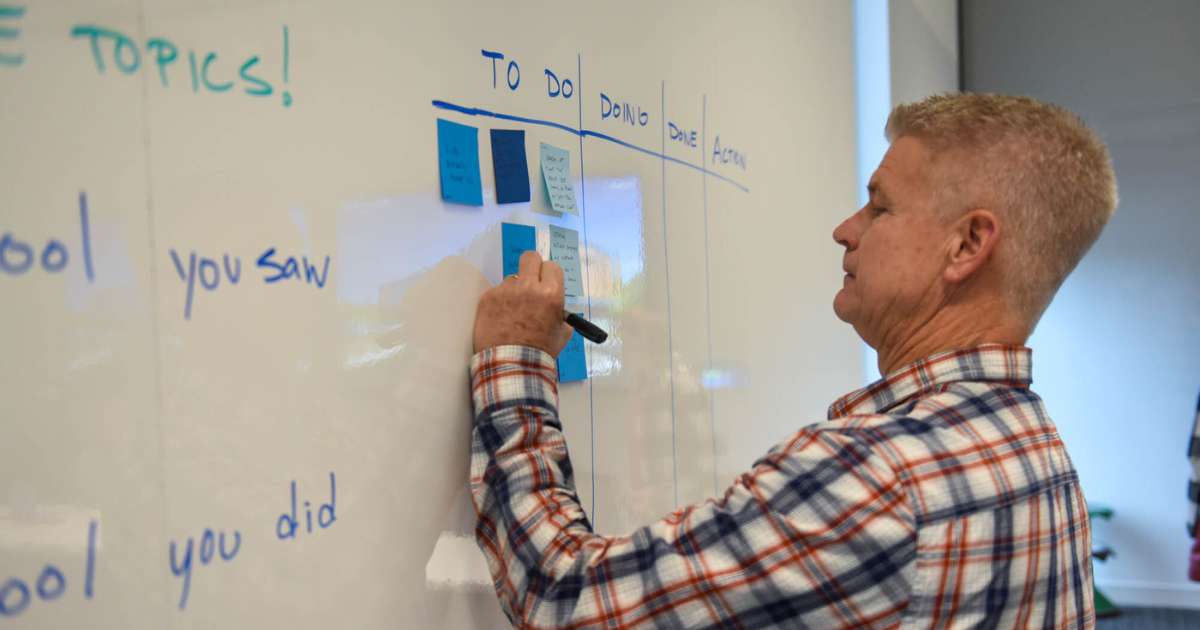
Almost every time I facilitate Lean Coffee meetings, someone will follow up afterward to ask, “What was that meeting style called? Can you share a ‘how-to’?”
Well, I didn’t have one. And a quick Google search, like “how to run a lean coffee meeting,” only leads to long articles, hard-to-parse explanations, and companies trying to sell you a tool.
So, if you’re familiar with the Lean Coffee format and looking for the CliffsNotes version of how to run a meeting with this facilitation style, you’re in the right place.
Here’s a short and sweet overview of the Lean Coffee meeting format recipe:
- Step 1. Get the room ready (virtual or in-person).
- Step 2. Explain the process.
- Step 3. Facilitate the meeting.
- Step 4. Wrap things up.
That’s pretty much it! If you’d like to dig into each step, I’ve included more below for context and clarity.
How a Lean Coffee Meeting Works
Whether you’ve experienced a Lean Coffee meeting with someone at SEP or have seen this style somewhere else entirely, the basic concepts are the same. Here’s a recipe for facilitating a Lean Coffee meeting:
Step 1. Get the room ready (virtual or in-person).
When meeting in person, your supplies include:
- Sticky notes
- Sharpies
- Whiteboard
Before the meeting begins, draw these columns on the board: TO-DO | DOING | DONE | ACTION
In a virtual or hybrid meeting, I create the experience above with virtual tools like:
- A Zoom meeting
- Trello, Google Sheets, or Cardboard to mimic sticky notes on a whiteboard

Step 2. Explain the process.
Whether or not your group is familiar with Lean Coffee meetings, plan to explain how you intend to facilitate them. Here’s my go-to:
One-Hour Lean Coffee Meeting Facilitator Example Script
Thanks for being here! Here’s how this will work:
Generate Topics (4 mins)
Everyone adds topics they’d like to discuss on sticky notes on the wall (e.g. Something cool you did, something cool you saw, something you want input on).
Read in topics (3 mins)
Everyone gets 20 seconds to explain their sticky.
Dot vote (3 mins)
Everyone take your Sharpie to dot vote on two favorite topics. You can put two votes on one topic if you really like it. I’ll put the ranked list in the To-Do column on the whiteboard.
Discussing (40 mins)
Set the timer for 7 minutes and start discussing the first topic. Continue or move on: When the timer runs out, ask for Up, Meh, or Down thumb vote on whether the group is finished with this topic or would like to continue. If it’s finished, move it into the Done column, then proceed to the next topic.
Lean Coffee Meeting Thumb Voting

Wrap up (10 mins before the hour)
Discuss any action items, then share them out after the meeting.
Step 3. Facilitate the meeting.
Now you run the process described and make sure you keep the room conversation flowing. As the facilitator, here are a few helpful tips:
- Look for laggards.
There are always a few people that don’t get the process as quickly as others. Be prepared to come alongside and help them catch up so they can participate. - This isn’t about you.
I recommend not adding your own ideas to the discussion. This meeting format is intended to be inclusive and give participants agency in the discussion. As the facilitator, make it more about people in the room discussing what they want to talk about. - You’re the timekeeper.
I find it helpful to run the timer on your phone with a silent alert, so you can subtly add time if a discussion feels rich. It’s not pleasant when someone is mid-sentence, and your phone starts quacking (but some people love the quacking!). - Have a plan for ties.
You might have some ties when rearranging the board after the votes have been tallied. Have a plan for how you will handle those (e.g. arrange alphabetically, choose the one in your right hand, etc.). - Be (or find) a scribe.
Take notes and help determine action items after the course of discussion points.

Step 4. Wrap things up.
Hopefully, you (or your designate) took good notes about action items or leftover topics. Review the action items you captured with the group, clarify them with the group, identify any you missed, and ensure each has an owner.
Leftover topics could either be saved for a future discussion or thrown out.
By the way, wrapping things up 10 minutes before the scheduled meeting ends is a pro move – most people hate running over! 10 minutes should be more than enough time to wrap things up and get people out on time.
When to Use Lean Coffee Meetings
You Want the Room to Choose Their Own Adventure
As noted above, this meeting style is quite versatile. It is an excellent method to use when you have more stuff to talk about than you have time since the group works together to generate the meeting agenda with topic brainstorming and dot voting.
This can also be a really handy tool for times you find yourself in an agenda-less meeting or—surprise!—find out you are the meeting facilitator when you arrive. 🙃
Staying Organized in Agenda-less Meetings
At SEP, we follow the A.R.T. of a Meeting model to minimize the number of agenda-less meetings. However, miscommunications can happen, and using the Lean Coffee meeting format can quickly organize a meeting and make it productive with minimal planning.
It’s a very interactive approach to meetings that’s collaborative and feels good when you are participating. It best serves things like peer groups, brainstorming, innovation, and practice guilds- any group wanting to have a substantive open dialog.
Final Thoughts
By the nature of the meeting style, Lean Coffee meetings:
- Decentralize ideas
- Even the playing field
- Are not driven top-down
- Breathe life back into boring meetings
Lean Coffee is an inclusive approach to running a meeting and can be used to ensure everyone’s voice gets heard in your organization. I hope you find these tips helpful in facilitating your next meeting. I’d love to hear what’s working for your meetings—hit me up on LinkedIn!
See how we tackle our toughest problems together.
Learn more about our collaborative culture at SEP.
You Might Also Like